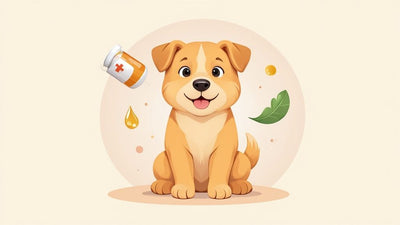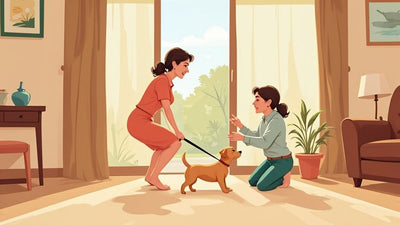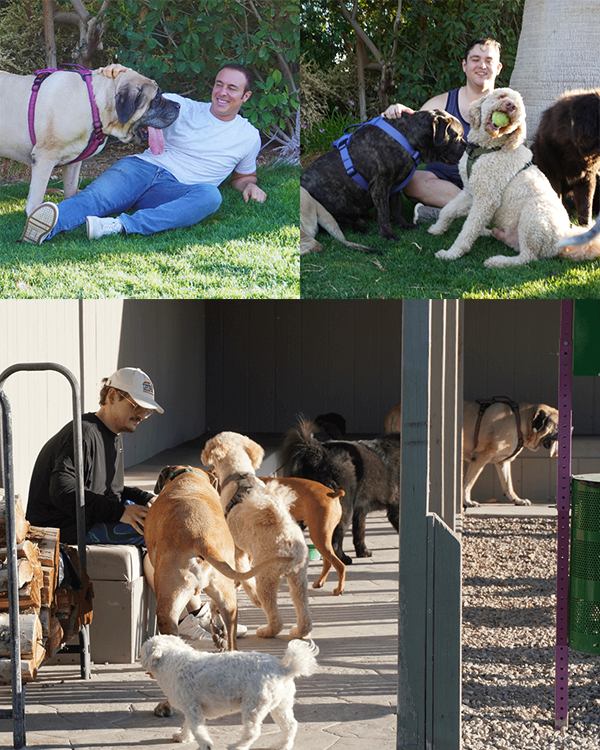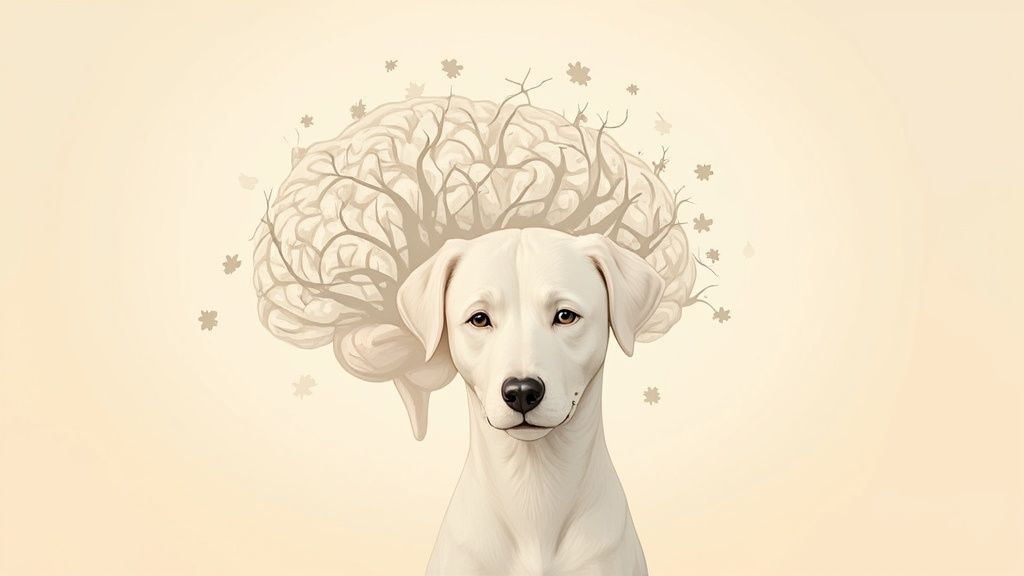
Recognizing the Signs of Canine Cognitive Dysfunction in Your Dog
It’s that quiet, unsettling moment. Your old friend stands and stares at a wall, looking lost in the very home they've known for years. You're not alone in those 3 AM worries, wondering if this is just old age or something more. The first signs of canine cognitive dysfunction often start small: a little disorientation, a shift in how they interact, or a change in their sleep. We understand.
Is It Just Old Age, or Something More?
This is a question every loving dog parent eventually asks. You start to notice subtle shifts—maybe they hesitate at the top of the stairs, seem confused by the back door, or forget a command they’ve known their whole life. It’s easy to brush it off as them "slowing down," but these little moments can be clues that their inner world is changing.
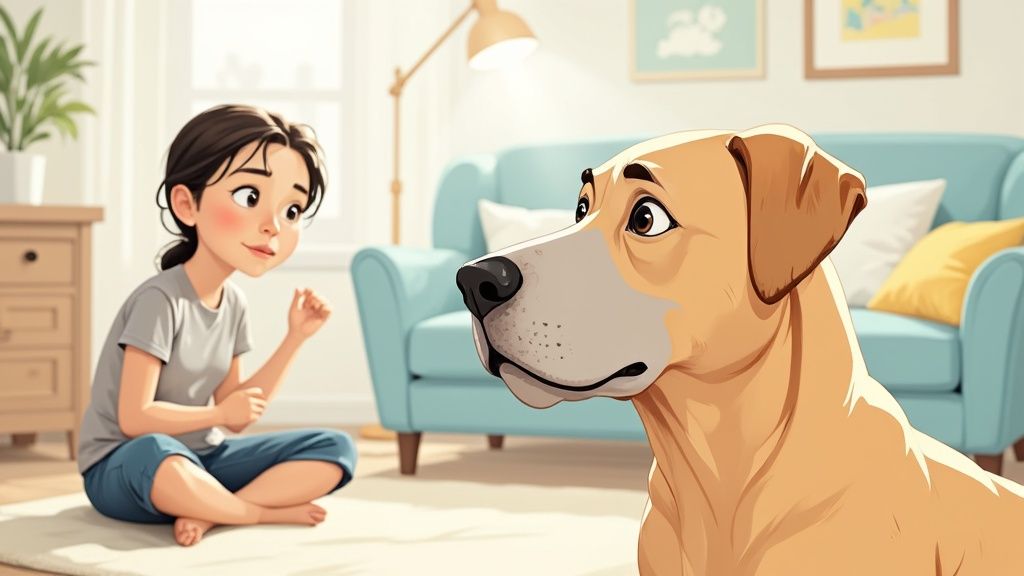
Canine Cognitive Dysfunction (CCD), sometimes called dog dementia, doesn't just appear overnight. It's more like the gradual, subtle changes that happen in an aging brain. The brain's communication pathways, which used to connect instantly, now have a harder time. Think of it like a familiar hiking trail that’s become a bit overgrown with time.
Recognizing the Early Signs
Trust your gut—you aren't imagining things, and you're certainly not alone on this journey. The earliest signs are often mistaken for normal aging, which is why paying close attention is one of the most loving things you can do. These early symptoms are your dog’s way of showing you their world is starting to feel different.
Some of the first behaviors you might notice include:
- Forgetting Familiar Routes: Suddenly stopping on your daily walk, looking around as if they don't recognize the way home.
- Staring Blankly: Seeming to "zone out" while looking at a wall, into a corner, or just off into space.
- Increased Anxiety at Night: Pacing, panting, or whining after the sun goes down, even when you're right there with them.
- Less Enthusiasm for Greetings: Not rushing to the door with that same tail-wagging excitement when you come home.
Seeing these changes can be both confusing and heartbreaking. It’s so important to remember this isn't disobedience; it's a sign that your dog needs your patience and support now more than ever. Many of these behaviors are directly linked to changes in the brain affecting memory, spatial awareness, and their ability to make sense of their surroundings.
We measure progress in peaceful nights and moments of recognition. Small improvements are worth celebrating and are a testament to the compassionate care you provide.
The first step is learning to spot the difference between an occasional senior moment and a consistent pattern of confusion. You can get a better handle on these shifts by reading our guide on aging dog behavior changes. Recognizing these patterns early means you can start providing proactive support, focusing on creating more good days together. This journey is about maintaining their comfort, helping their mental clarity, and honoring the incredible bond you've always shared.
Get Your FREE Dog Brain Health Guide

Get instant FREE access to today's top ways to help your best friend live a longer, healthier, happier life.
- 39 value-packed pages of expert insights
- Early-detection tips for cognitive decline
- Top brain-boosting superfoods
- Vet-approved mental sharpness strategies
- Fun IQ tests for your dog
The Core Signs of Cognitive Decline in Dogs
Watching your dog's behavior change as they age is one of the toughest parts of being a pet parent. It's easy to feel worried or confused. We want you to know that these aren't just random quirks; they're signals that your dog’s inner world is changing. Understanding them is the first step toward helping.
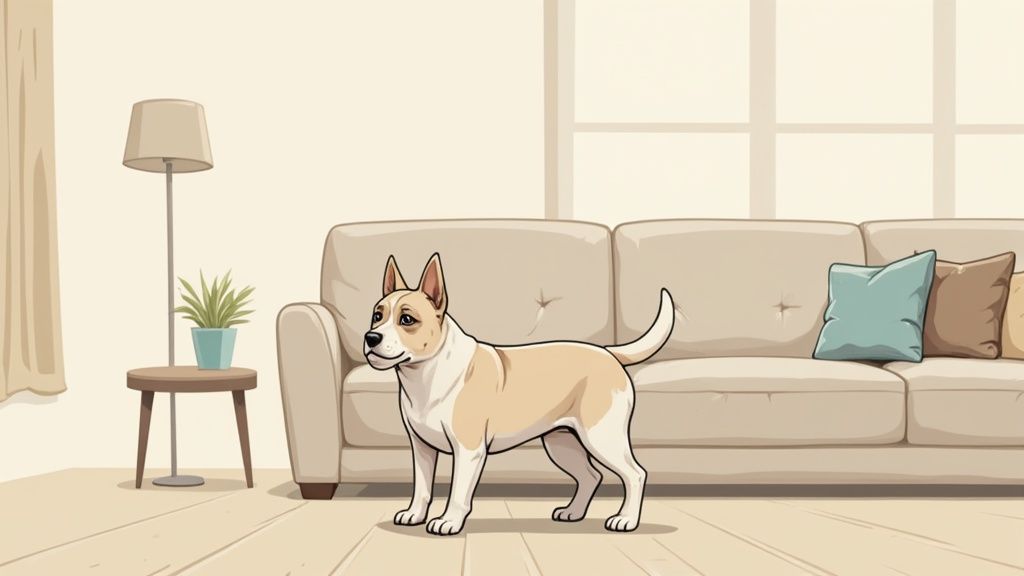
To help make sense of it all, veterinarians and behavior experts often use a helpful acronym: DISHAA. Think of it as a simple checklist to organize what you're seeing. This turns confusing actions into understandable patterns, giving us a shared language to talk about what's happening with our best friends.
DISHAA Symptoms at a Glance: What to Look For
Here's a quick breakdown of the DISHAA acronym. This table can help you pinpoint specific behaviors that might be related to cognitive decline.
| Symptom Category (DISHAA) | What It Means for Your Dog | Common Examples You Might See |
|---|---|---|
| Disorientation | Your dog seems lost or confused in familiar surroundings. The mental map of their world is becoming fuzzy. | Getting stuck in corners, staring at walls, forgetting the purpose of a door. |
| Interaction Changes | The way your dog connects with you, other pets, and family members has changed noticeably. | Becoming more withdrawn and aloof, or becoming unusually clingy and needy. |
| Sleep-Wake Cycle | Their internal clock is off, leading to restless nights and sleepy days. | Pacing, whining, or barking at night; sleeping much more than usual during the day. |
| House Soiling | A previously house-trained dog starts having accidents inside. | Forgetting to signal they need to go out; having an accident right after being outside. |
| Activity Changes | There's a general decrease in purposeful activity and interest in their usual routines. | Less enthusiasm for walks, no longer playing with toys, repetitive licking or circling. |
| Anxiety | New or worsening fears and stress, often because their world feels unpredictable and confusing. | Increased separation anxiety, new fear of noises, easily startled or agitated. |
Let's dig a little deeper into what each of these categories really looks like in our day-to-day lives with our senior dogs.
Disorientation: The Feeling of Being Lost
This is one of the most common and, frankly, heartbreaking signs. It’s like the well-worn paths in their mind are fading. Your dog, who has navigated your home for years, suddenly seems completely lost.
You might see this as:
- Getting Stuck: Finding your dog standing in a corner or behind a chair, looking like they have no idea how to get out.
- Forgetting Familiar Places: Staring blankly at the door they've always used to go outside, as if it’s a brand-new object.
- Wandering Aimlessly: Pacing through the house with no clear purpose, sometimes for long stretches at a time.
This isn't your dog being stubborn; it's genuine confusion. They're trying to make sense of a world that no longer feels familiar. Your calm, gentle guidance can be a huge comfort.
Interaction Changes: A Shift in Your Bond
The very nature of your relationship can feel different. The way your dog interacts with you and other family members—both human and furry—can change. This is often a direct result of their inner confusion.
Some dogs become less interested in petting or playtime. Others swing the opposite way, becoming "velcro dogs" who need constant reassurance. You might also notice they don't greet you at the door with the same old enthusiasm. These social shifts are a core part of what defines dog cognitive dysfunction syndrome and are a clear call for extra patience from us.
Sleep-Wake Cycle Alterations: Restless Nights and Sleepy Days
Is your dog sleeping soundly all day, only to wander the halls all night? This topsy-turvy sleep schedule is a classic sign of CCD. The part of the brain that regulates their internal clock gets disrupted.
This often leads to:
- Nighttime Restlessness: You might hear whining, panting, or barking for no clear reason in the middle of the night.
- Increased Daytime Sleeping: They may seem lethargic and spend far more time snoozing during the day than they used to.
Those peaceful nights can feel like a distant memory, but even small improvements are possible. A predictable routine and the right supportive nutrition can go a long way in helping them find a more natural rhythm.
House Soiling: Forgetting Lifelong Habits
Accidents in the house from a dog who has been perfectly trained for years can be frustrating. We get it. But it's almost never intentional. More often, it's a symptom of cognitive decline.
Your dog might simply be forgetting the habit of asking to go outside. Or, they might not recognize the physical urge to go until it’s too late. It’s also common for them to have an accident right after coming inside because they got disoriented and forgot why they were out there.
Activity Level Changes: A Loss of Purposeful Action
Sure, all senior dogs slow down. But with CCD, the change is often more profound. It's not just about having less physical energy; it's about a loss of interest and purpose.
Your dog might show little excitement for walks, stop playing with their favorite toys, or start repetitive behaviors like licking the floor. This isn't laziness. It's a sign that their brain is struggling to initiate familiar activities.
Every small moment of clarity—like your dog remembering where their favorite toy is hidden—is a win. We celebrate these small victories because we know they mean everything.
Anxiety: New Fears and Heightened Stress
Finally, a spike in anxiety is a huge component of canine cognitive dysfunction symptoms. Imagine it from their perspective: a world that's confusing is also a scary one.
New fears can pop up seemingly overnight. Your dog might become terrified of the vacuum cleaner or easily startled by everyday sounds. Separation anxiety can also get much worse. Providing a safe, predictable home environment is one of the kindest things you can do to bring them comfort on this journey.
What’s Happening Inside Your Dog’s Brain?
When you see your best friend staring blankly at a wall, you can't help but wonder what's going on. It’s a mix of worry and confusion. Understanding the "why" behind these changes helps shift your mindset from frustration to compassionate, supportive care.
The behaviors you’re seeing have a real, physical cause. Think of your dog's brain as a busy city with a complex network of roads—these are the neural pathways that hold memories and learned behaviors. As dogs age, some of these roads can develop roadblocks, making it harder for messages to get through.
The Brain's Communication System Slows Down
One of the main culprits behind these roadblocks is something called beta-amyloid plaques. You can picture these as tiny bits of sticky "clutter" that slowly build up between the brain's nerve cells. This clutter interferes with the brain's signals, making it harder for messages to travel. It’s like trying to have a conversation with bad cell reception—the connection is fuzzy.
This is what leads to the outward signs of cognitive decline. When your dog takes longer to respond to their name, it's not because they're being stubborn. It’s a physical challenge their brain is working to overcome.
This plaque buildup is a known hallmark of cognitive decline in both dogs and humans. In fact, studies show a direct link between the amount of this brain clutter and how severe a dog’s symptoms are. You can dive deeper into the science and read the full research about these brain changes if you're curious.
The Role of Reduced Blood Flow
Another big piece of the puzzle is blood flow. The brain is an energy-hungry organ that needs a constant supply of oxygen and nutrients to function at its best. As some dogs age, the circulation to their brain can decrease.
Imagine a garden hose that's getting a bit kinked. The water still comes out, but the flow isn't as strong or steady. This reduced flow can affect everything from mental sharpness to their ability to sleep soundly.
This is why supporting healthy circulation is just as important as protecting the brain cells themselves. We need to help clear the communication pathways and make sure the brain is getting the fuel it needs.
How This Changes Things for Your Dog
Knowing that these are real, physical changes can be a relief. It allows you to replace any feelings of frustration with empathy. Your dog isn't intentionally forgetting their potty training; their brain is just navigating a new, more difficult terrain.
We want you to feel empowered by this knowledge. You are your dog’s best friend. Every small thing you do, from gently guiding them to supporting their brain health with the right nutrition, makes an enormous difference. Together, you can focus on what truly matters: making every day a good day.
How Common Are These Symptoms in Senior Dogs?
If you're noticing these changes, please know you are not alone. It's a quiet worry to carry when you see the dog you've known for years start to seem confused. But these symptoms are far more common than most people think.
The single biggest factor is simply age. As our dogs get older, the odds of them showing at least one sign of cognitive change go up quite a bit.
The Numbers Behind the Symptoms
Research backs up what so many families are seeing firsthand. A major study showed a steep increase in symptoms as dogs age.
- For dogs between 8 and 11 years old, about 8% showed signs.
- This jumps to nearly 45% for dogs aged 13 to 15.
- It climbs again to a staggering 67% for those between 15 and 17.
- By age 17, 80% of dogs were found to be affected.
What's really surprising is that the same study found that very few of these dogs had been officially diagnosed by a vet. This means countless families are trying to figure this out on their own. You can read more about these findings from the study to get the full picture.
We know these statistics can feel heavy. The point isn't to scare you, but to validate what you're seeing. It’s real and common. Noticing it means you're an incredibly caring and observant person.
Recognizing these patterns is the first step. From here, you can work with your vet to build a plan that helps your dog feel comfortable and maintains their quality of life.
Lifestyle and Its Impact
Age is the main driver, but lifestyle can play a role, too. A lack of physical and mental activity, in particular, can increase the risk. Just like with people, an active mind and body are good for the brain. When a senior dog's world starts to shrink, it can sometimes speed up these changes.
The takeaway here isn’t about blame. It’s about seeing where you can provide gentle support. Even small things, like a short walk or a simple puzzle toy, can make a difference and give you more good days together.
This infographic helps visualize some of the changes happening inside your dog's brain that cause these symptoms.
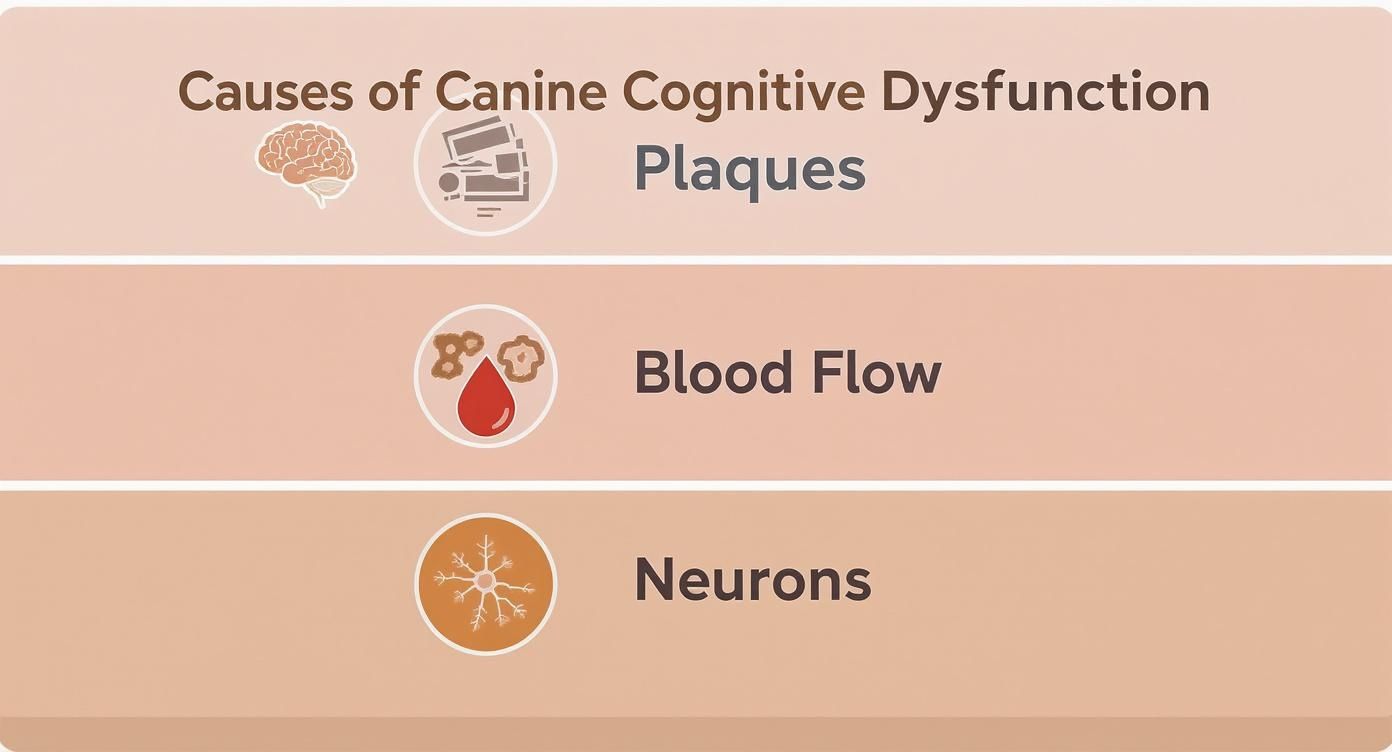
As the image shows, things like brain "clutter," reduced blood flow, and neuron damage all add up to the confusion your dog might be feeling.

Support Your Dog's Brain Health with NeuroChew™
As mentioned in this article, NeuroChew is the first dog chew designed to support both cognitive function and healthy circulation. Perfect for dogs showing early signs of cognitive decline or for proactive brain health support.
Practical Ways to Support Your Aging Dog
Watching your old friend struggle with confusion is heartbreaking. We know that feeling well. But please, don't feel helpless. While we can't talk about cures, there is so much you can do to support your dog’s comfort and clarity. The goal is simple: create more good days together.
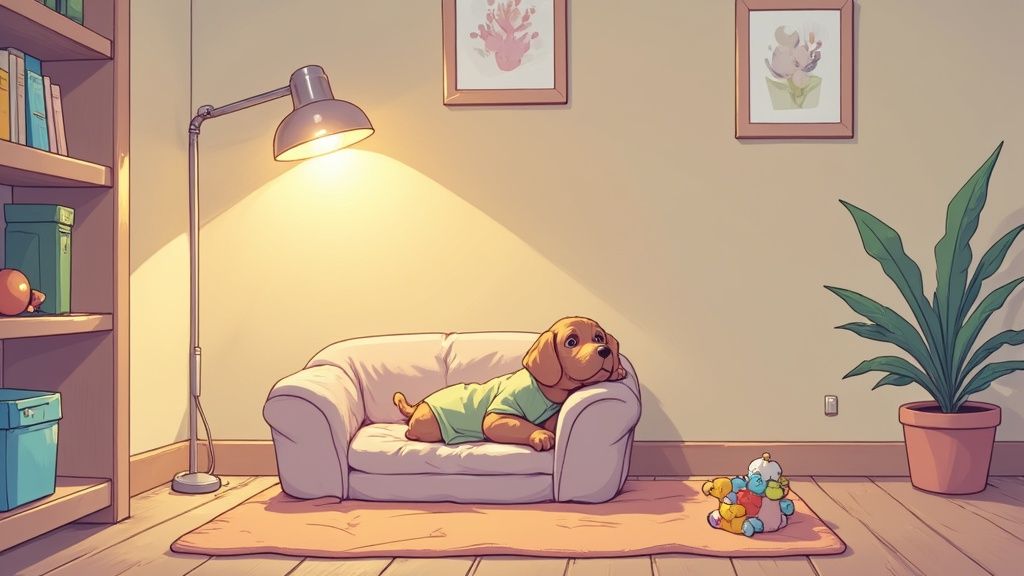
This isn’t about huge, overwhelming changes. It’s about making small, thoughtful adjustments to their environment and routine. These compassionate actions can make a world of difference in helping them navigate their world with more confidence.
Creating a Safe and Predictable Environment
Imagine your internal map becoming fuzzy. That’s what’s happening to your dog. By making their physical world as clear and safe as possible, you provide immense comfort. The goal is to reduce confusion and prevent accidents, which helps lower their anxiety (and yours, too).
Here are a few simple supports you can put in place:
- Add Nightlights: Placing low-wattage nightlights in hallways, near their bed, and by the water bowl can work wonders for disorientation after dark.
- Use Non-Slip Rugs: Older dogs often lose their footing—and their confidence—on slick floors. Adding runners and rugs creates secure pathways between their key spots.
- Keep Things Consistent: Now is not the time to rearrange the living room. A predictable layout lets them rely on muscle memory when their cognitive map gets scrambled.
- Create Clear Paths: Make sure walkways are free of clutter. A shoe left in the hallway can become a confusing and stressful obstacle for a dog with CCD.
These adjustments are all about building a supportive foundation. They help your dog feel secure in the one place they should always feel safest: home.
The Comfort of a Consistent Routine
For a dog experiencing cognitive changes, predictability is a powerful antidote to anxiety. When they know what to expect, their world feels less chaotic. Think of a consistent daily schedule as an anchor in their sea of confusion.
Try to keep these key activities at the same time each day:
- Meal Times: Feed them at the same time every morning and evening.
- Potty Breaks: Take them out on a regular schedule—first thing in the morning, after meals, and right before bed. This will dramatically reduce accidents.
- Bedtime: A consistent "lights out" time helps regulate those sleep-wake cycles.
You're not just creating a schedule; you're building a comforting rhythm for your dog's day. This predictability eases their mental load, allowing them to relax.
Gentle Mental and Physical Enrichment
Keeping your dog's mind and body active is still important, but the focus shifts to gentle engagement. We're not talking about strenuous hikes or complex new tricks. The goal is to stimulate their brain and body in ways that build confidence, not frustration.
A comprehensive study by the Dog Aging Project drove this point home. The data showed that dogs classified as 'not active' had a 6.47 times higher chance of showing canine cognitive dysfunction symptoms compared to very active dogs. That’s a huge connection, telling us that maintaining gentle activity is a key strategy for supporting brain health. You can see more on these important findings on the Dog Aging Project's research.
Here are a few simple enrichment ideas:
- Scent Games: Hide a favorite treat under a blanket and let them use their nose to find it. Their sense of smell often remains sharp.
- Slow Feeder Bowls or Puzzle Toys: These encourage them to think during mealtime. Just be sure to choose simple puzzles to avoid frustration.
- Short, Sniffy Walks: Let them lead the way and sniff to their heart's content. A 10-minute walk filled with new smells can be more enriching than a 30-minute forced march.
Nutritional Support for Brain Health
Just as we adjust their physical world, we can also support their internal world through nutrition. An aging brain has specific needs, and targeted nutrients can help protect brain cells and promote mental clarity.
Key ingredients that support brain health often include antioxidants to shield cells from damage and compounds that support healthy blood flow. This ensures the brain gets the oxygen and nutrients it needs. Providing this kind of natural support is a foundational piece of any holistic care plan. You can learn more by exploring our guide on understanding cognitive decline in dogs.
By weaving these practical strategies together, you create a loving, supportive environment that helps your dog navigate their golden years with comfort, dignity, and more good days by your side.
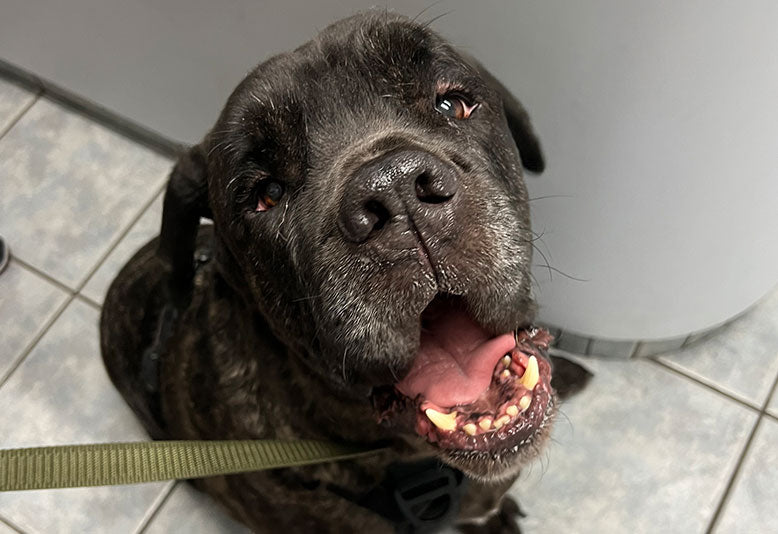
Real Results: How NeuroChew Helped Brutus Regain His Mental Clarity
Brutus was getting disoriented at night. After starting NeuroChew, he's more happy during the day and steady at night. He's back to his old self!
Working with Your Vet is a Partnership
You and your dog are a team, and your veterinarian is an important player on it. We know it can feel daunting to bring up concerns about canine cognitive dysfunction symptoms. But starting that conversation is the best thing you can do for clarity and support. You are your dog's number one advocate.
Your vet's first job is to rule out other medical conditions that can look a lot like cognitive decline. Things like arthritis, kidney problems, or even hearing loss can cause similar behavioral changes. This is why the observations you bring from home are so valuable.
How to Prepare for Your Vet Visit
To get the most out of your appointment, it helps to come prepared. A little prep work ensures you don't forget any crucial details.
- Be Specific About Behaviors: Instead of saying your dog seems "confused," describe exactly what's happening. For instance, "He got stuck behind the couch three times this week," is much more helpful. Another great example is, "He paced by the back door from 2 to 4 a.m. last night."
- Track the Frequency: Note how often these things are happening. Is the pacing a nightly ritual, or does it only happen once a week? This context is important.
- Prepare Your Questions: Don't hesitate to ask clarifying questions. Good ones include, "What other conditions could be causing these signs?" or "What are the next steps for creating a support plan?"
Remember, this is a true partnership. Your detailed observations, combined with your vet's medical expertise, will create the clearest picture of what's going on.
This process isn't about getting a scary label. It’s about finding the right path forward to help your dog feel their best. Together with your vet, you can navigate this chapter with confidence, keeping the focus on giving your best friend more good days.
Your Top Questions About Canine Cognitive Dysfunction
It's completely normal to have a million questions running through your head. When you're facing something like this, the uncertainty can be overwhelming. We've gathered some of the most common questions we hear, with straightforward answers to give you some comfort.
At What Age Do Dogs Typically Show Signs of CCD?
Every dog is an individual, but the first quiet signs of cognitive decline often start to surface when a dog is between 8 and 11 years old. As they get older, these signs become more common.
Studies have shown that by the time dogs are 13 to 15 years old, nearly half of them show at least one symptom. Think of these numbers less as a scary deadline and more as a gentle nudge to be extra observant as your friend enters their golden years.
Is There a Cure for Canine Cognitive Dysfunction?
Right now, there is no "cure" for CCD in the sense that we can't reverse the physical changes happening in the brain. But it's so important to remember what we can do.
You are far from helpless. By making thoughtful changes to their diet, adjusting their environment, and sticking to a comforting routine, many dog parents see real improvement in their dog's daily happiness and clarity. It's all about creating more good days together.
Are Some Dog Breeds More Likely to Get CCD?
That's a fantastic question. While age is the single biggest risk factor, the research we have today shows that canine cognitive dysfunction symptoms can appear in any breed. It doesn't matter if you have a Chihuahua or a Great Dane.
What truly matters is a dog's age, overall health, and lifestyle—keeping them gently active is key. So instead of focusing on breed, it's much more helpful for all senior dog parents to simply be aware of the behavioral changes we've talked about.
How Do Vets Diagnose Canine Cognitive Dysfunction?
There isn't a single, simple test for CCD, like a blood draw. Instead, your veterinarian will arrive at a diagnosis by carefully ruling out other possible causes for the symptoms you're seeing.
This process of elimination usually includes:
- A complete physical exam.
- Blood work to check for other health problems that can mimic CCD, like kidney or thyroid issues.
- A detailed conversation with you about the specific changes you've seen at home.
The notes you take are incredibly valuable here. You know your dog better than anyone. Your observations about pacing, confusion, or sleep changes are the most important clues you can give your vet.
At Furever Active, we believe that nurturing your dog's brain health is a profound act of love. We developed our NeuroChew™ supplement to offer natural, gentle support for their mental sharpness and well-being, helping you and your best friend share more moments of connection. Learn more about how we can support your family at https://fureveractive.com.
Share This Article

Support Your Dog's Brain Health with NeuroChew™
The first dog chew that supports both brain function and healthy circulation. Perfect for dogs of all ages.
- Enhances cognitive function & mental clarity
- Reduces anxiety without sedation
- Supports healthy blood circulation
- Made in USA with natural ingredients
60-Day Money-Back Guarantee • Free Shipping



